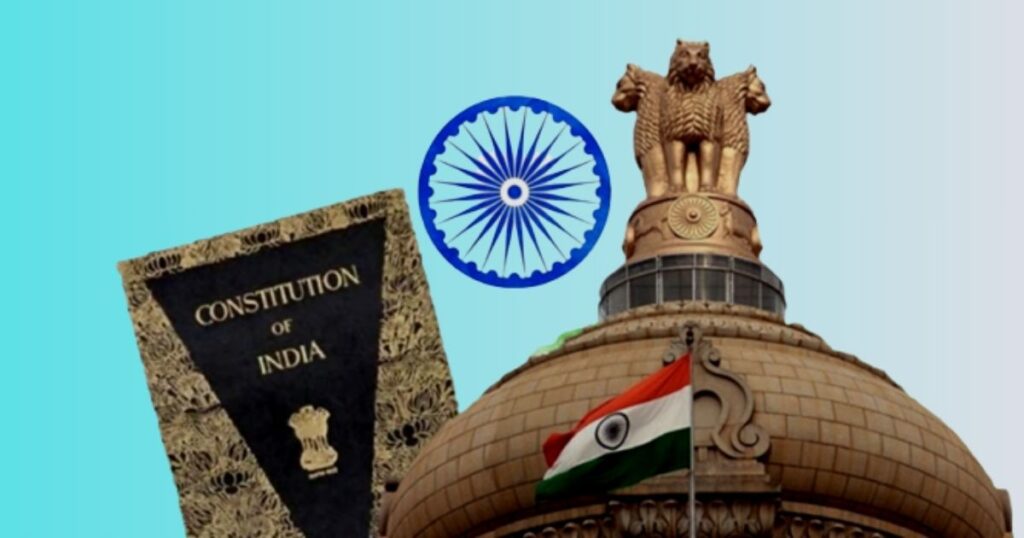The basic Structure Doctrine of the Indian constitution is one of the most important constitutional doctrines in India. The Indian Constitution is the supreme law of the land, and It establishes the fundamental principles that form the basis of the Indian Constitution, including the preservation of essential features and basic constitutional values. In this section, we will explore the Basic Structure Doctrine in detail, including its historical context, principles, and significance in upholding the integrity and democratic values of the Indian Constitution. We will also examine the role of the judiciary in interpreting and applying the Basic Structure Doctrine in landmark constitutional cases.
To know more about applying the Basic Structure Doctrine in brief, please refer to the video below:
Key Takeaways:
- The Basic Structure Doctrine is a constitutional doctrine in India that establishes the fundamental principles of the Indian Constitution.
- It is intended to preserve the essential features and basic constitutional values of the Indian Constitution.
- The judiciary plays a key role in interpreting and applying the Basic Structure Doctrine in constitutional cases.
- The Basic Structure Doctrine has had a significant impact on India’s legal framework and constitutional jurisprudence.
- In the following sections, we will explore the Basic Structure Doctrine in more detail, including its historical context, principles, and challenges for the future.
What is the Basic Structure Doctrine?

The Basic Structure Doctrine is a fundamental tenet of the Constitution of India that upholds the essential features and basic constitutional values enshrined in the document. The doctrine is a constitutional doctrine in India that seeks to protect the fundamental structure of the Indian Constitution from any attempt to alter it beyond recognition.
The Indian Constitution is the supreme law of the land and provides the framework for the functioning of the Indian Republic. The doctrine ensures that any changes made to the Constitution do not violate its basic features, which include the supremacy of the Constitution, the separation of powers, the federal structure, and the protection of fundamental rights.
The fundamental structure of the Indian Constitution is a set of principles that are considered to be the pillars of Indian democracy. These principles include the rule of law, fundamental rights, democratic principles, secularism, and judicial review.
The Basic Structure Doctrine is an essential safeguard that ensures the core values of the Constitution are respected and not easily altered. It is a constitutional doctrine in India that has been cemented by the judiciary, which has held that certain provisions of the Constitution cannot be amended without violating the Basic Structure Doctrine.
The Indian Constitution Doctrine is founded on the concept of protecting the fundamental structure of the Indian Constitution from any attempt to destroy it. The Doctrine recognizes that the Constitution must evolve and adapt over time to meet the changing needs of society, but the basic principles and values must remain intact.
Historical Context of the Basic Structure Doctrine
The Basic Structure Doctrine emerged as a result of India’s tumultuous constitutional history, marked by an ongoing struggle to balance the need for stability and continuity with the desire for change and progress. The Indian Constitution has been amended multiple times since its adoption in 1950, with several controversial amendments threatening the survival of the constitutional structure in India.
One of the most significant events that paved the way for the emergence of the Basic Structure Doctrine was the 24th Constitutional Amendment Act, of 1971. This amendment sought to exclude challenges to constitutional amendments from judicial review, which raised concerns about the possibility of unchecked legislative power and the erosion of the Constitution’s basic structure.
Subsequently, in the landmark case of Golaknath v. State of Punjab (1967), the Supreme Court of India held that fundamental rights were so integral to the basic structure of the Indian Constitution that they could not be amended. This decision sparked a nationwide debate on the power of Parliament to amend the Constitution and fueled calls for judicial intervention to safeguard the Constitution’s essential features from arbitrary amendments.
The Basic Structure Doctrine was finally established in the watershed case of Kesavananda Bharati v. State of Kerala (1973), where the Supreme Court held that while the Parliament had the power to amend the Constitution, it could not alter its basic structure or essential features. This decision marked a significant shift in India’s constitutional jurisprudence, firmly establishing the doctrine of constitutional supremacy and the principle of judicial review in India.
Principles of the Basic Structure Doctrine
The Basic Structure Doctrine is based on the principle that the Constitution of India has certain basic features that cannot be altered or destroyed by amendments. This doctrine was established to ensure that the Constitution remains true to its fundamental principles and values and that the constitutional structure in India is not compromised by any legislative or executive action.
Some of the key principles of the Basic Structure Doctrine include:
- Preservation of essential features: The Basic Structure Doctrine seeks to preserve the essential features of the Constitution, such as the supremacy of the Constitution, the democratic and republican form of government, the separation of powers, and the federal character of the Constitution.
- Preservation of basic constitutional values: The doctrine also seeks to preserve the basic constitutional values enshrined in the Constitution, such as social justice, equality, liberty, and fraternity.
- Limitations on the constituent power: The Basic Structure Doctrine places limitations on the constituent power of the Parliament, which cannot amend the Constitution in a manner that destroys its basic structure or fundamental values.
- Interpretation by the judiciary: The doctrine leaves the interpretation of the basic structure of the Constitution to the judiciary, which has the power to strike down any constitutional amendment that violates the basic structure of the Constitution.
The principles of the Basic Structure Doctrine form the foundation of the constitutional structure in India, ensuring that the Constitution remains true to its fundamental principles and values and that the democratic spirit of the Constitution is preserved.
Significance of the Basic Structure Doctrine of the Indian Constitution
The Basic Structure Doctrine is one of the most important constitutional doctrines in India, as it plays a crucial role in safeguarding the structure of the Indian Constitution. By preserving the essential features of the Constitution, the Basic Structure Doctrine ensures that the Constitution remains a living document that can adapt to changing social, political, and economic needs.
One of the most significant aspects of the Basic Structure Doctrine is its impact on fundamental rights in the Indian Constitution. The doctrine ensures that the fundamental rights of Indian citizens, such as the right to equality, freedom of speech and expression, and the right to life and personal liberty, are protected from any attempt to dilute or undermine them.
The Basic Structure Doctrine also ensures that the distribution of powers between the executive, legislative, and judiciary branches of the government is maintained. It ensures that no branch of government becomes too powerful, thereby protecting the democratic foundations of the Indian Constitution.
The significance of the Basic Structure Doctrine is further emphasized by its role in preventing constitutional amendments that threaten the fundamental structure of the Indian Constitution. The Supreme Court of India has used the Basic Structure Doctrine to strike down several constitutional amendments that were deemed to be incompatible with the basic features of the Constitution.
Overall, the Basic Structure Doctrine plays a crucial role in preserving the structure and integrity of the Indian Constitution. Its significance is felt in every aspect of the Indian legal system, from fundamental rights protection to the distribution of powers between the branches of government.
Judicial Interpretation of the Basic Structure Doctrine
The Basic Structure Doctrine has been an essential tool for the judiciary in India to interpret and protect the constitutional framework of the country. The Supreme Court of India has used this doctrine in various landmark cases to safeguard the fundamental principles and values enshrined in the Indian Constitution.
One of the earliest and most prominent cases where the Basic Structure Doctrine came into play was the Kesavananda Bharati case of 1973. In this case, the Supreme Court declared that the Parliament’s power to amend the Constitution was not absolute and that it could not alter the Constitution’s basic structure. The Court further laid down that the essential features of the Constitution could not be amended, and the Parliament’s amending power was subject to the doctrine of basic structure.
Since then, the Basic Structure Doctrine has been applied in several other cases, including the Minerva Mills case, the Kihoto Hollohan case, and the S.R. Bommai case, among others. These cases have established the Basic Structure Doctrine as a vital principle of constitutional interpretation in India.
It is worth noting that the interpretation and application of the Basic Structure Doctrine have not been without controversy. There have been instances where the courts have been accused of judicial activism and overstepping their boundaries by interfering with the policymakers’ domain. However, for the judiciary, the Basic Structure Doctrine has been a necessary tool to ensure that the Constitution’s fundamental principles are upheld, and the democratic values of the country are preserved.
In the next section, we will examine the impact of the Basic Structure Doctrine on India’s legal framework.
Impact on India’s Legal Framework

The Basic Structure Doctrine has had a significant impact on India’s legal framework since its establishment. By upholding the fundamental structure of the Indian Constitution, the Basic Structure Doctrine has provided a solid foundation for the Indian legal system, serving as a safeguard against any potential threats to its democratic values.
The application of the Basic Structure Doctrine has resulted in constitutional amendments, legislative acts, and executive actions being subject to judicial scrutiny, ensuring that they do not violate the essential features and basic constitutional values of the Indian Constitution. This has helped preserve the integrity of the Indian Constitution by preventing any efforts to dilute or undermine it through unconstitutional means.
The Basic Structure Doctrine has also played a crucial role in protecting the fundamental rights of Indian citizens. By requiring that any constitutional amendment or legislative act that impacts the basic structure of the Indian Constitution be subject to judicial scrutiny, the Basic Structure Doctrine ensures that the rights of Indian citizens are not curtailed or violated by actions taken by the government.
The impact of the Basic Structure Doctrine can be seen in several landmark constitutional cases, such as Kesavananda Bharati v. State of Kerala, where the Supreme Court held that the basic structure of the Indian Constitution was inviolable and could not be abrogated even by a constitutional amendment.
Overall, the Basic Structure Doctrine has had a profound impact on India’s legal framework, serving as a bulwark against any efforts to dilute or undermine the fundamental structure, essential features, and basic constitutional values of the Indian Constitution.
Debates and Criticisms of the Basic Structure Doctrine
The Basic Structure Doctrine has been a subject of intense debate and criticism since its inception. One of the key criticisms of the doctrine is that it gives unelected judges the power to strike down constitutional amendments passed by the elected representatives of the people.
Some also argue that the Basic Structure Doctrine creates uncertainty and unpredictability in the law, as it is difficult to define what constitutes the “basic structure” of the Indian Constitution.
Another criticism is that the doctrine has been used as a tool for judicial activism, with some judges using it to impose their values and preferences on society.
Despite these criticisms, supporters of the Basic Structure Doctrine argue that it plays a crucial role in protecting the fundamental principles of the Indian Constitution from arbitrary changes by the government.
Moreover, many legal experts believe that the doctrine is an essential safeguard against attempts to undermine the basic features of the Constitution, such as secularism, democracy, and the rule of law.
Overall, while the Basic Structure Doctrine remains a contested constitutional doctrine in India, it continues to be a significant tool for protecting the integrity and democratic values of the Indian Constitution.
Future Prospects and Challenges
The Basic Structure Doctrine has played a crucial role in preserving the fundamental values and principles of the Indian Constitution. However, its prospects and potential challenges cannot be ignored, particularly in the context of evolving constitutional jurisprudence in India.
The emergence of new issues and challenges, including those related to national security, economic development, and social justice, may require a re-evaluation of the existing framework of the Basic Structure Doctrine. In addition, the increasing politicization of the judiciary and the growing influence of majoritarian ideologies may pose a threat to the autonomy and independence of the judiciary in upholding the doctrine.
Moreover, the scope and application of the Basic Structure Doctrine regarding specific constitutional provisions, such as the power of the President to promulgate ordinances or the power of Parliament to amend the Constitution, remains a matter of debate and controversy.
Therefore, it is important for India’s legal community, policymakers, and citizens to engage in thoughtful discussions and debates on the prospects and challenges of the Basic Structure Doctrine. Any changes or modifications to the doctrine must be made to preserve the fundamental values and principles of the Indian Constitution, including the protection of fundamental rights and the promotion of democracy, secularism, and the rule of law.
Comparative Analysis with Other Jurisdictions
The Basic Structure Doctrine is a unique feature of the Indian Constitution that sets it apart from other constitutional doctrines around the world. While some countries have similar doctrines, such as the “implied limitations” doctrine in the United States, the Basic Structure Doctrine is more comprehensive and explicit in preserving the fundamental structure of the Indian Constitution.
In contrast to the Indian Constitution, the United States Constitution does not explicitly recognize a basic structure but rather relies on a system of enumerated powers and checks and balances among the three branches of government. Similarly, the Constitution of the United Kingdom is largely unwritten and relies on a mix of statutes, case law, and conventions to maintain its constitutional structure.
However, there are some similarities between the Basic Structure Doctrine and other constitutional doctrines around the world. For example, the “eternity clauses” in the German Constitution and the Constitution of South Africa limit the ability of the government to make certain types of amendments that would undermine the fundamental principles of the constitution.
Despite these similarities, the Basic Structure Doctrine remains a unique and powerful feature of the Indian Constitution, reflecting its commitment to preserving democratic values and protecting fundamental rights.
Conclusion
Now that you have a thorough understanding of the Basic Structure Doctrine of the Indian Constitution, you can appreciate its significance in upholding the fundamental values and democratic principles of the Indian legal framework.
The Basic Structure Doctrine plays a pivotal role in preserving the essential features of the Constitution, including the separation of powers, federalism, and the protection of fundamental rights. By establishing a framework that upholds the integrity and supremacy of the Indian Constitution, the Basic Structure Doctrine ensures that India remains a vibrant and democratic country.
However, the application of the Basic Structure Doctrine is not without its controversies and challenges. There are ongoing debates and criticisms surrounding its interpretation and scope, particularly in the context of evolving constitutional jurisprudence in India.
Nevertheless, the Basic Structure Doctrine remains a vital element of Indian constitutional law and jurisprudence. By safeguarding essential constitutional values and upholding fundamental rights, it ensures that India continues to be a beacon of democracy and justice in an ever-changing world.
You Can Read: Dr. B.R. Ambedkar’s Views on Indian Constitution, Social Justice & Economics
What is the Basic Structure Doctrine of the Indian Constitution?
FAQ
Q: What is the Basic Structure Doctrine?
A: The Basic Structure Doctrine refers to the principle in the Indian Constitution that certain essential features and fundamental values of the Constitution are beyond the scope of amendment by the Parliament. It ensures the preservation of the basic structure of the constitution and protects the democratic and foundational principles of India.
Q: What is the historical context of the Basic Structure Doctrine?
A: The Basic Structure Doctrine emerged through a series of constitutional amendments and judicial interpretations. It originated in the landmark case of Kesavananda Bharati v. State of Kerala in 1973, where the Supreme Court of India upheld the doctrine to protect the fundamental rights and democratic essence of the Indian Constitution.
Q: What are the principles of the Basic Structure Doctrine?
A: The principles of the Basic Structure Doctrine include the preservation of essential features and basic constitutional values. It ensures that the principles of democracy, federalism, secularism, independence of the judiciary, and the rule of law are safeguarded and cannot be altered or abolished through constitutional amendments.
Q: What is the significance of the Basic Structure Doctrine?
A: The Basic Structure Doctrine has significant importance in upholding the integrity and supremacy of the Indian Constitution. It acts as a safeguard against arbitrary changes to the constitution, protects fundamental rights, and ensures the stability and continuity of the constitutional framework in India.
Q: How is the Basic Structure Doctrine interpreted by the judiciary?
A: The judiciary, particularly the Supreme Court of India, is responsible for interpreting and applying the Basic Structure Doctrine. It exercises the power of judicial review to determine whether any constitutional amendments violate the basic structure of the Constitution and renders them invalid if found to be so.
Q: How does the Basic Structure Doctrine impact India’s legal framework?
A: The Basic Structure Doctrine has a profound impact on India’s legal framework. It influences the interpretation of laws, constitutional amendments, and executive actions to ensure their compatibility with the basic structure of the Constitution. It acts as a check on legislative and executive power, promoting constitutionalism and the protection of fundamental rights.
Q: What are the debates and criticisms surrounding the Basic Structure Doctrine?
A: The Basic Structure Doctrine has been subject to various debates and criticisms. Some argue that it restricts the power of the Parliament to amend the constitution, while others believe it provides necessary checks and balances to prevent arbitrary changes. There are ongoing discussions about its scope, boundaries, and the role of the judiciary in determining the basic structure of the Constitution.
Q: What are the prospects and challenges for the Basic Structure Doctrine?
A: The Basic Structure Doctrine faces prospects and challenges in the evolving constitutional jurisprudence of India. It will continue to shape the development of constitutional law and its application in various contexts. Challenges include balancing the need for stability with the demands for change and addressing emerging constitutional issues in the modern era.
Q: How does the Basic Structure Doctrine compare with similar doctrines in other jurisdictions?
A: The Basic Structure Doctrine has unique aspects specific to the Indian context. While there are similarities with other constitutional doctrines worldwide, such as the doctrine of unamendable provisions, the Basic Structure Doctrine stands out for its emphasis on preserving the essential features and fundamental values of the Indian Constitution.
People Also Read: What are the Fundamental Rights in the Indian Constitution?











1 thought on “The Basic Structure Doctrine of the Indian Constitution”